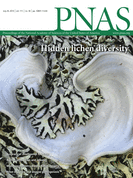Faculty members at the University of North Carolina School of Dentistry, The Scripps Research Institute (TSRI) and other institutions have discovered links between a set of genes known to promote tumor growth and mucoepidermoid carcinoma, an oral cancer that affects the salivary glands. The discovery could help physicians develop new treatments that target the cancer’s underlying genetic causes.

The research, recently published online ahead of print by the Proceedings of the National Academy of Sciences, shows that a pair of proteins joined together by a genetic mutation – known as CRTC1/MAML2 (C1/M2)– work with MYC, a protein commonly associated with other cancers, to promote the oral cancer’s growth and spread.
The C1/M2 protein is created when the genes encoding CRTC1 and MAML2 mutate into a single gene through a process known as chromosomal translocation. Such mutant “chimera” genes are linked to the formation of several forms of cancer. The team discovered that the C1/M2 protein further activates genetic pathways regulated by MYC, in addition to CREB, to begin a series of cellular changes leading to the development of mucoepidermoid carcinoma.
“The identification of unique interactions between C1/M2 and MYC suggests that drugs capable of disrupting these interactions may have therapeutic potential in the treatment of mucoepidermoid carcinomas,” said Antonio L. Amelio, Ph.D., first author of the study who is now assistant professor with the UNC School of Dentistry and member of the UNC Lineberger Comprehensive Cancer Center.
Researchers have known about the role of C1/M2 and its interactions with another protein CREB in the development of mucoepidermoid carcinoma, and physicians screen patients for the presence of the C1/M2 protein when testing for this cancer. These new findings deepen the understanding of C1/M2’s role by revealing that it works with a family of cancer-associated genes known as the MYC family to drive the cellular changes necessary for a tumor to develop.
“CREB has been regarded as a key accomplice in the progression of some forms of caner but the mechanism has been elusive,” added TSRI biologist Michael Conkright, Ph.D., corresponding author of the study. “This research provides new molecular insights into the role of CREB activation in malignances.”
“Our hope is to better understand the role that CREB and CRTCs play in cooperating with other pathways such as MYC to drive the creation and progression of oral, head, and neck cancers. We believe that cross-talk between the CREB signaling network and known cancer-causing networks such as MYC is important for the transition to metastatic disease and that we may be able to exploit this to develop a novel class of therapeutics to battle some cancers,” said Dr. Amelio.
The discovery of these new protein interactions may also reveal insights into the mechanisms behind other cancers that arise due to other genetic mutations involving the CREB and MYC pathways.
In addition to Dr. Amelio and Dr. Conkright, other authors of the study, “CRTC1/MAML2 gain-of-function interactions with MYC create a gene signature predictive of cancers with CREB–MYC involvement,” include Mohammad Fallahi, Franz X. Schaub, Min Zhang, Mariam B. Lawani, Adam S. Alperstein, Mark R. Southern, Brandon M. Young, Lizi Wu, Maria Zajac-Kaye, Frederic J. Kaye, and John L. Cleveland.
The research was supported in part by a Howard Temin Pathway to Independence Award in Cancer Research from the National Cancer Institute (NCI) (K99-CA157954), National Institutes of Health/NCI R01 Grant CA100603, a PGA National WCAD Cancer Research Fellowship and Ruth L. Kirschstein National Research Service Award from the National Cancer Institute (F32-CA134121), the Margaret Q. Landerberger Research Foundation, a Swiss National Foundation Postdoctoral Fellowship and monies from the State of Florida to TSRI’s Scripps Florida.
